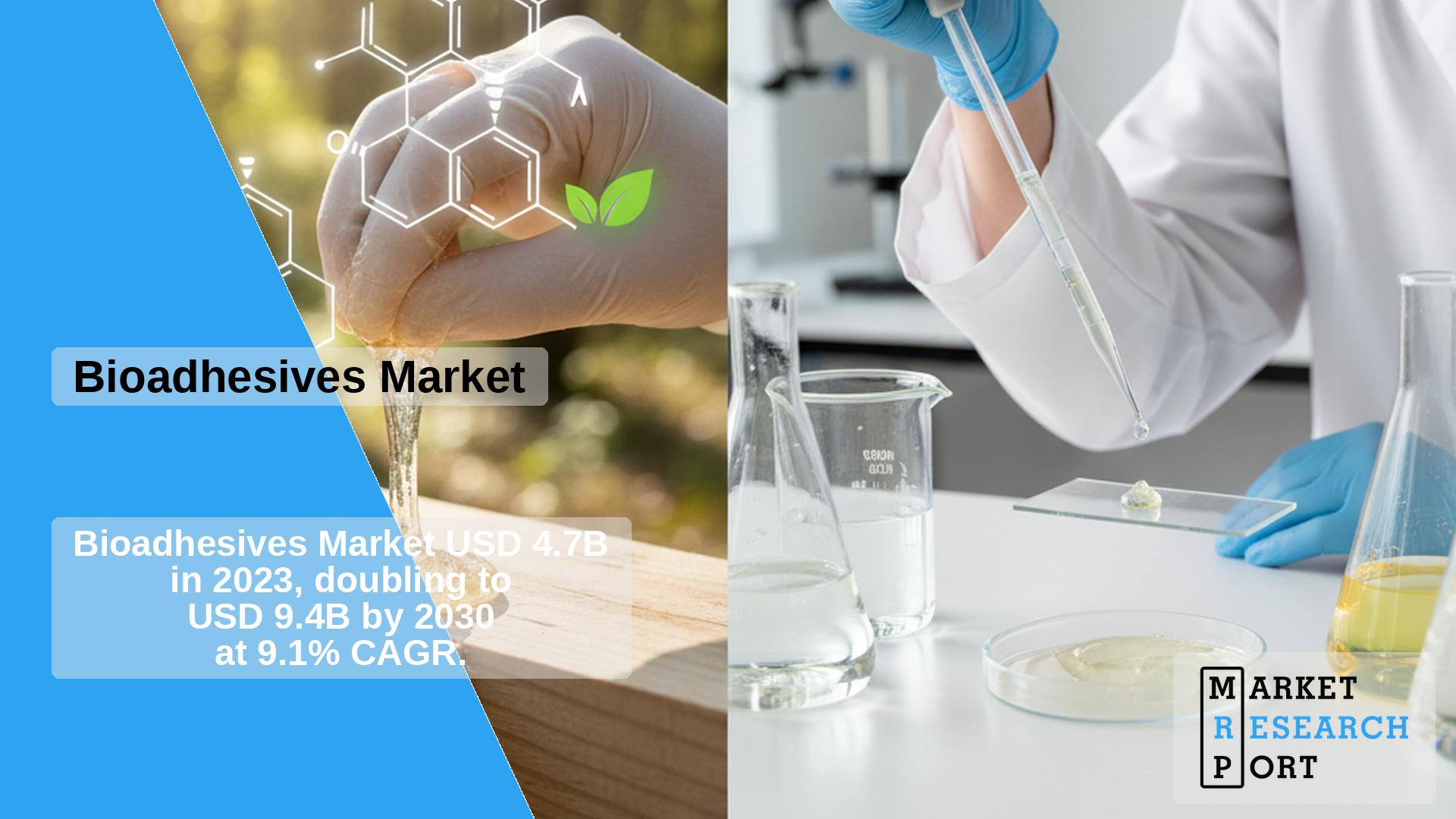
The global bioadhesives market was valued at approximately USD 4.7 billion in 2023 and is expected to reach USD 9.4 billion by 2030, growing at a compound annual growth rate (CAGR) of 9.1% between 2024 and 2030. This growth is attributed to advances in bioadhesive formulations enhancing their performance and the development of novel bioadhesive products with improved properties.
Bioadhesives encompass natural polymer-based substances with adhesive properties and synthetic compounds modified for biological binding. They also include adhesives derived from biological intermediates such as cellulose, starch, and gelatins.
The rising awareness of the health risks associated with synthetic materials has increased demand for natural bioadhesives. Government regulations promoting environmental sustainability and biomass-derived products have further encouraged manufacturers to invest in innovative bioadhesive technologies.
Growth is additionally supported by investments in R&D and broad applications across industries, notably biomedical sectors like wound care, drug delivery, surgery, and medical device attachment systems. The abundant availability of soy, starch, and corn as raw materials further bolsters production capacity and growth.
Plant-based bioadhesives dominated the market due to their non-petrochemical origins and low formaldehyde emissions. Made from materials such as rubber, lignin, starch, and soy, they enjoy strong demand from sustainability-focused industries. Among plant-based bioadhesives, starch-based variants offer superior performance owing to higher viscosity.
Animal-based bioadhesives, used mainly in medical applications like wound care and tissue engineering, are forecasted to grow at a CAGR of 9.6%. However, their adoption is limited compared to plant-based adhesives, partly due to ethical concerns.
The paper and packaging segment led the market, contributing 35.0% of revenue in 2023. This includes applications in specialty packaging, bags, cartons, flexible packaging, disposable products, envelopes, labels, and cigarette packaging. Adhesives for frozen food packaging and printing also fall under this category, with bioadhesives providing safe alternatives free from harmful components.
The construction sector is expected to register significant growth, utilizing bioadhesives in wood composites like particleboard and fiberboard, as well as wood products such as doors and windows. Benefits include strong bonding, durability, low toxicity, and enhanced moisture resistance. The rise of sustainable building materials and green construction techniques further amplifies demand.
North America held the largest bioadhesives market share worldwide in 2023, driven by demand across packaging, paper, and construction industries. The market is propelled by industrial growth and shifting preferences towards sustainable products.
The U.S. dominates North America, with companies investing in R&D to create advanced bioadhesives. Market expansion occurs across various sectors including healthcare and packaging, driven by demand for safer, eco-friendly adhesives.
The UK market is growing rapidly due to increasing environmental awareness and stricter regulations targeting VOC emissions. Rising construction activity and growing usage in sectors like paints and coatings support this growth. Increasing circular economy initiatives prompt industries to adopt bioadhesives over conventional alternatives.
Germany is a key player in Europe, with growth supported by bio-based chemical production, strict environmental laws, and innovation focused on sustainability within adhesives manufacturing.
Asia Pacific is expected to exhibit strong growth fueled by expanding construction, packaging, and healthcare sectors. Demand for bioadhesives in products like pipes, panels, and pavements is increasing.
China leads the region with robust manufacturing capacity and government support promoting eco-friendly adhesives. Increasing demand from e-commerce packaging further strengthens the market.
Leading companies include Henkel, DuPont, Arkema, Ashland, Beardow Adams, Paramelt, Jowat, Ingredion, and Tate & Lyle. These firms focus on innovation and strategic partnerships to enhance market presence.
| Attribute | Details |
|---|---|
| Market Size (2023) | USD 4.7 billion |
| Projected Size (2030) | USD 9.4 billion |
| Growth Rate (CAGR) | 9.1% (2024-2030) |
| Base Year | 2023 |
| Historical Data | 2018-2022 |
| Forecast Period | 2024-2030 |
| Units | Revenue (USD million), CAGR (2024-2030) |
| Coverage | Revenue Forecast, Competitive Landscape, Growth Drivers |
| Segments | Source, End-Use, Region |
| Regions Covered | North America, Europe, Asia Pacific, Latin America, MEA |
| Countries Covered | US, Canada, Mexico, UK, Germany, Italy, Spain, Austria, China, India, Japan, South Korea, Brazil, Argentina, Saudi Arabia |
| Key Companies | Henkel, DuPont, Arkema, Ashland, Beardow Adams, Paramelt, Jowat, Ingredion, Tate & Lyle |